Today, let’s start with weddings. Or more accurately, let’s start with wedding rings. Now, this is just a random starting point, but wedding rings will do for now, seeing as we love nothing better than to upset your Mondays. Of course, you know what a wedding ring represents: that joyous circle of golden happiness symbolic of the pure and everlasting mushiness between a man and a woman (or between any other combination of gender you prefer). This ring is anticipated by most women (or any other gender you prefer) as the most profound gift a man (or any other gender you prefer) can give as a sign of true love. Right?
Wrong. Well, partially wrong. The historical origins of wedding rings are a whole distance separate from their current perception. The wedding ring wasn’t a romantic exchange between a man and his love. Hell, no. It was simply the symbolic gift from the groom’s family to the bride to indicate final payment of the agreed price. There was nothing romantic and mushy about the ring giving—it was simply an exchange of valuable goodies for the wedding.
And by “exchange of valuable goodies”, we mean: the dude got the intact virgin in exchange for the gold ring and the other jewelry his family gave her family. Of course, the modern symbolism of the ring has changed from that historical origin. The idea that the wedding ring is a symbol of “eternal love and devotion” is a newer idea; men didn’t even start wearing rings until the 20th century, presumably after unbearable pressure from the female rights movement to the effect that, what’s sauce for the goose should not be a three-course meal for the gander.
Now, where are we going with this excursion into marital traditions? Nowhere, really, like we said earlier. Except to point out the lesson to be learnt from the difference between one’s perception and actual reality. You see, prior to your opening this page, your perception of the wedding ring and its origins was, probably, that the ring has always been some sort of sacred romantic bond, instead of a sacred economic one. But this is irrelevant now—seeing as the whole job has been corkscrewed into a new meaning today. What is relevant, however, is that not all that glitters is gold.
Let’s look at another example of misguided perceptions. If you are an avid explorer of twitter bios—like most of us jobless people around here—you must have come across the anomaly of folks who seem to know absolutely nothing about themselves, describing themselves in superlative terms that tells a huge lesson in the boundlessness of the human ego. And this falsity applies both to their location—and you’ll be surprised how many people confuse “London” for “Lagos”—and also to the simple fact of their own self-awareness.
And that’s what Socrates and the ancient Greeks meant when they said, “Gnōthi Seauton” or in a more lively language: “know yourself.” This same idea is continued by Shakespeare in Hamlet, when Polonius says to his son: “To thine own self be true, and it must follow, as the night the day, thou canst not then be false to any man.” Or to put it in proper English: if you understand your own nature well enough, you won’t suck up to other people.
And that’s the moral for today: the ability to define one’s self accurately is the starting point to achieving one’s goals. You should know the difference between one thing and another for as the effing philosophers put it: A = A and nothing else. A society in which perception and reality are confused with each other is going to be a damned inefficient one. Today’s society, stimulated with the religious idea that faith is a key to achieving anything, has gone gaga on this principle, even way beyond the intentions of the original teaching. And so, for faith, we substitute a confused misrepresentation of reality and define our circumstances through our perceptions instead of the facts. But in the smart words of Jesus, “Suppose one of you wants to build a tower. Won’t you first sit down and estimate the cost to see if you have enough money to complete it?” Now, that’s a thought on being realistic.




As the Oracle at Delphi puts it, “Man know thyself.”
LikeLike
Following the winding paths of Ayo’s minds is one of my favourite pastimes. Another lovely piece…
LikeLike
all laughing at not all that shivers is cold.
Very apt. reality and perception are no longer properly deciphered by most these days. many lead fake lives.
LikeLike
still laughing*
LikeLike
Ayo! I am in love wit ur mind. All dat shivers is not cold gaan ni heehehehehe.
LikeLike
Pingback: ONE THING, AND THEN ANOTHER | greenlight
Nice one, Ayo! I loved it.
LikeLike
So so true. Who am I? A tot for another day! Thanks boss
LikeLike
Wow, this boy always makes my head spin. What craftsmanship!
LikeLike